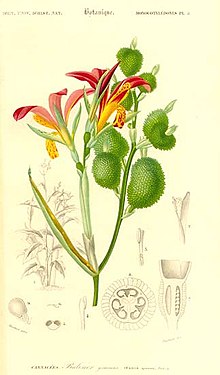| Revision as of 00:23, 16 April 2010 editFlakinho (talk | contribs)Extended confirmed users27,468 editsm Changing the font of the title to italic← Previous edit | Revision as of 10:29, 2 September 2010 edit undo72.83.149.134 (talk) Improved sort order in Category CannaceaeNext edit → | ||
| Line 41: | Line 41: | ||
| * ] | * ] | ||
| ] | ] | ||
| ] | ] | ||
Revision as of 10:29, 2 September 2010
| Canna speciosa | |
|---|---|

| |
| Scientific classification | |
| Kingdom: | Plantae |
| (unranked): | Angiosperms |
| (unranked): | Monocots |
| (unranked): | Commelinids |
| Order: | Zingiberales |
| Family: | Cannaceae |
| Genus: | Canna |
| Species: | C. speciosa |
| Binomial name | |
| Canna speciosa (Roscoe) Hook | |
Canna speciosa (Roscoe) Hook. is a species of the Canna genus, belonging to the family Cannaceae, a native of the tropical Americas. Introduced to England from South America in 1820, speciosa meaning 'showy'. (Johnson's Gardeners Dictionary, 1856).
It is a perennial growing to 2m. It is hardy to zone 10 and is frost tender. In the north latitudes it is in flower from August to October, and the seeds ripen in October. The flowers are hermaphrodite.
Synonyms
- Canna indica var. speciosa (Roscoe ex Sims) Baker
Taxonomy
In the last three decades of the 20th century, Canna species have been categorised by two different taxonomists, Paulus Johannes Maria Maas from the Netherlands and Nobuyuki Tanaka from Japan. Maas considers C. speciosa to be a synonym of C. indica L., however, Tanaka's DNA assays demonstrate that the C. indica complex can be clearly distinguished from other taxa, as a result he recognises this as a separate species.
Canna speciosa (Roscoe) Hook.
C. speciosa is a tall, slender plant with an upright stem covered along its entire length with large, stalkless, gracefully arching leaves. The plant bears heads of striking, bi-colored flowers with scarlet petals and a conspicuous contrasting yellow throat. (D'Orbigny's Dictionnaire D'Histoire Naturelle 1849)
References
- Cooke, Ian, 2001. The Gardener's Guide to Growing cannas, Timber Press. ISBN 0-88192-513-6
- Johnson's Gardeners Dictionary, 1856
- Tanaka, N. 2001. Taxonomic revision of the family Cannaceae in the New World and Asia. Makinoa ser. 2, 1:34–43.